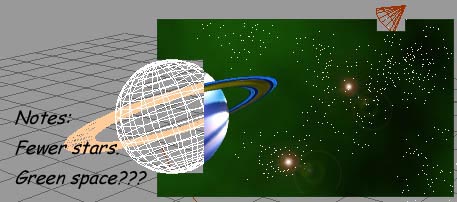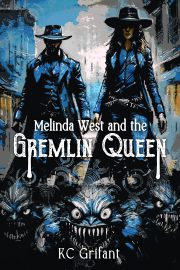Building New Worlds: Construction and Influences
by Stephen Baxter

Copyright © 1995 by Stephen Baxter. First published in the Fall 1995 issue of the Bulletin.
Many reviewers have pointed out the influence on much of my work of James Blish’s classic hard sf tale “Surface Tension” (1952). Parallels with “Surface Tension” show up most strongly in those of my stories which might be described as “world-building,” in the Hal Clement tradition. Some of my scenarios are seen as evocative of the pond-world of Blish’s microscopic humans; some of my scenes are described as homages to Blish; and so on.
At first this perception startled me: sure, “Surface Tension” made a powerful imprint on me in my teenage years, and it remains one of my favourite pieces. But I wasn’t aware, until it was pointed out by others, that its influence on my own work was quite so strong.
Of course, when constructing a new hard sf tale, I don’t consciously set out to build in references to “Surface Tension,” or anything else. My attention is on the development of an original science fiction idea, and how it is to be embedded in the structure of the story. But clearly my influences, “Surface Tension” among them, do play a part in the shaping of the material. And the reviewers’ comments set me wondering how this happens. How do I go about creating a world-building tale? And at what level do my influences, including “Surface Tension,” work on me?
![]()
“World-building” stories feature protagonists (humans or aliens) living in environments very different from our own. In general, the story is designed to display the features of that environment. And where I have written tales featuring humans suspended in a fluid of some kind, straightforward – if superficial – parallels with “Surface Tension” are, I guess, easy to draw.
In “Downstream” (1993) for example, a colony of humans are surviving in a fast-flowing stream; in “The Blood of Angels” (1995) humans are suspended in a sea which frequently freezes; “Cilia-of-Gold” (1994) is about fish-like creatures surviving in passages deep within Mercury, and “Inherit the Earth” (1992) is a far-future tale set on an abandoned Earth, about sea-bottom creatures provided with sentience by a robot Pope. My first novel Raft (1991) was set in a high-gravity universe, and the plot centred on humans living in free fall in a nebula surrounding a black hole. So all of these can be seen, on one level, as variations on the theme of Blish’s water-world physical scenario. In my fourth novel Flux (1993) the parallels with “Surface Tension” are perhaps even more clear: suspended in a superfluid layer inside a neutron star, microscopic humans struggle to survive…
But in terms of their construction I would argue that these works have converged on “Surface Tension,” rather than deriving from it in any direct way.
My stories generally derive from a single, central scientific idea: my personal method is to start with the idea and proceed towards the central characters and the plot.
“Downstream,” for example, was inspired by a brief passage in a natural history TV program about creatures who survive in rushing rivers: an environment in which life is all about catching stuff being washed down from upstream, and, most of all, hanging on. This extraordinary situation caught at my imagination, and from that seed I developed the idea by addressing a series of (fairly outrageous) questions.
What if people tried to survive in such an environment? – I imagined primitive colonies, clinging to rock faces. How did the people get there? The answer to that became a key feature of the plot. There could be no two-way communication up and down the river; perhaps the evolution of isolated colonies would diverge… I imagined the corpses of differently-evolved upstream para-humans washing down the stream over the heads of my protagonists.
So I had an interesting scenario, but as yet no story to tell.
Every tale needs conflict, between characters and each other, and their environment. So we have people living in a stream. So what? Who’s it hurting? My answer in this case was: the guy who lets go, and is washed downstream, unable – ever – to return to his family.
With that as the core of the story’s tension, I developed a plot designed to dramatise the features of my invented world.
![]()
The development of a scenario logically from a core idea shows up clearly, I think, in my novel Flux.
Flux is about humans adapted to live inside the Star – a neutron star. The ocean-like habitable Mantle is bounded above by the forests of the Crust and below by the deadly Quantum Sea; all around the primitive human encampments, lines of quantised vorticity – lethal and beautiful – stretch from Pole to Pole of the Star. Flux – the Star’s magnetic field – shapes the lives of Dura, my protagonist, and her people.
And Dura is tiny – a hundred-thousandth the size of you or me.
The seed idea for this scenario came from a brief paragraph in New Scientist about a rapidly-rotating neutron star. I wondered if such a star could spin so fast that centripetal forces at the equator could balance out the ferocious gravity… If you want to generate new and original ideas, you have to ask yourself outrageous questions. Such as: Could humans survive on the equator of a fast-spinning neutron star?
So I began to research more deeply into neutron stars. But I soon decided that my starting idea wouldn’t work: the zone of low-G would be very small, there would be awkward Coriolis forces, and the star would probably tear itself apart anyhow.
But I became intrigued by the interior of the star. I learned that a neutron star has a solid crust, of iron, and the interior is layered; at a certain depth, I found, there is a mantle of neutron superfluid, permeated by rope-like vortex lines…
My original idea was gone, but maybe I’d found somewhere else to colonise. And as far as I knew I was looking at a place nobody had visited before, although I was aware of Bob Forward’s Dragon’s Egg, about inhabitants of the surface of a neutron star.
So I decided to sculpt a race of analogue-humans to survive and prosper in the superfluid mantle.
The novel’s final scenario was the result of answering a lot of hard questions. Like, how big is Dura? That’s determined (as is your and my size) by the balance of forces governing her body. Because of her peculiar environment, Dura had to be microscopic… just as in “Surface Tension,” of course, but because of the logic of my scenario, not for any reference to Blish. How can Dura see, and hear? Light diffuses only slowly in the Mantle, but sound waves travel extremely fast. So Dura ‘sees’ sound, ‘hears’ heat, and ‘smells’ photons.
How does Dura get around? Well, she’s floating about in superfluid, but she can use induced currents in her body to ‘Wave’ across the Star’s powerful magnetic field… And what a wonderful idea that seemed; Dura could fly across the Pole of the neutron star. Straight away this development suggested images, fragments of scenes.
Yes, but what does Dura eat? Hmmm. To answer that I needed some kind of ecosystem – and an equivalent of the carbon bond. Does she excrete? If so, what?
Dura visits a huge City at the South Pole. (Huge? At least a centimetre across.) Fine. But if it’s a real city, what do they use for currency? How does the economy work? What kind of government do they have? What do they do with the sewage?
…Oh. And what about sex? Dura’s embedded in a superfluid. Presumably membranes rubbing against each other wouldn’t be too effective…
Building a world big enough to fill a hard sf novel involves a lot of heavy research. And I mean heavy: I’m talking about getting access to a university library or similar and going through (at least) undergraduate texts and research journals, like (in the case of Flux) The Astrophysical Journal. Online access makes this a lot easier, of course.
When I’m world-building, I have to reinvent everything, from the ground up. But happily I don’t have to work it all out in advance. None of my prior research on FLUX focused my imagination half so well as the moment when Dura opened her eyes and took her first look around… I use the first draft as an adventure of exploration for myself, a way of finding out what the book or story is about; I can fix any inconsistencies later, when I’m done discovering.
![]()
I want my stories to be more than simple puzzle-tales (though there’s nothing wrong with puzzle-tales!). So I work hard to deliver a charge of sensawunda to the reader. It seems to surprise readers that sf writers work consciously at making their stories wondrous!
Sensawunda can come from changing the reader’s perception, through dramatic revelations of the nature of the new world, from rushes of extrapolation of the central idea, from changes of scale or perspective. I like to let my imagination run riot: it’s my world, after all… although I try to be sure I take the reader with me.
For instance, by the final couple of drafts of Flux, I felt I needed a way to present the exhilaration of skimming at speed through the flux lines of my Star world. In the end (rather like Young Einstein) I decided there was only one possible solution: surfers.
Surfers, in a neutron star? You can see that by the end my world-building had taken me a long way from The Astrophysical Journal…
As I work on my fiction I am always aware of levels in the story above and beyond the bare physical idea: the river in “Downstream,” for example, could serve as a metaphor for the one-way progress of time. Such levels of meaning provide the story with a deeper significance: in fact I doubt if I’d select a notion for development if it didn’t have some resonance beyond simply being a Neat Idea. But when working I prefer consciously to concentrate on telling the tale: I let deeper concepts inform the work, rather than distorting the tale by bringing them out overtly.
I try to bear in mind a few simple rules in building my worlds. This is hard sf, so I should avoid breaking any known physical laws: indeed the scenario ought to proceed from what we know of the nature of things. Following the lead of HG Wells, I find that One Big Idea is generally enough for a story: everything should progress from that single seed. Show, don’t tell: even though the point of the story is the new world, the story is actually about the characters, with their world as a backdrop; if I want to point out some neat feature of my world it has to be relevant to – better, a significant contributor to – the story. A mark of success is a world- building story being reviewed without reference to the nature of the physical scenario itself ! – as Raft was, for example.
Of course, every ‘rule’ is there to be broken. The story’s the thing: I allow myself to do whatever I think needs to be done to make a story work.
So that’s how I build worlds. Of course, science fiction is like a long, extended dialogue, and probably works like Flux couldn’t exist if not for Mission of Gravity and “Surface Tension” and others. But for me the conscious construction of a new story is from outside the field on inwards: logical extrapolation from odd and intriguing bits of science to build a scenario, and then development of a compelling foreground tale designed to exploit the background.
Sure, there are parallels between the scenarios in, for example, Flux and “Surface Tension.” But the nature of my neutron-star world had come from a reasonably logical development of a core idea, not from conscious reference to “Surface Tension” or any other influence. I have humans swimming around in a fluid because that’s the way it has to be, not because I’m writing a homage to Blish. In the same way, the humans stranded in the high-G universe of RAFT are in free fall because the gravity field of any sizeable planet would crush them immediately.
I suspect that fiction derived solely from other fiction becomes attenuated. Hard sf is often seen as the seed bed for new ideas entering the field; and hard sf can only renew itself if we writers look outside for our material.
I’d argue this holds even for my sixth novel, The Time Ships, which is a sequel! – to HG Wells’s The Time Machine. As a sequel, of course Ships has strong roots in Wells’s fiction. But the book is at heart a big time-travel novel, drawing extensively on modern physicists’ thinking on the subject. So even here I’m trying to bring new material into the field.
Where the influence of “Surface Tension” – and all the other great sf I’ve absorbed over the years – does work on me, I guess, is in the process of selection and shaping of story material, possible plot developments, and so forth: here I’m not thinking of the physical scenario of “Surface Tension,” for example, but more of the freight of meaning Blish brings to his tale, and the craft with which he works his material. Possibly one of the most effective wonder-delivering scale- changes in all of sf is Blish’s brief passage describing, from an omniscient viewpoint, how “the two-inch wooden spaceship and its microscopic cargo toiled down the slope towards the drying little rivulet…”
I’m conscious I stand on the shoulders of giants. But my ambition is not to imitate Blish – not even to praise him (though there’s nothing wrong with that) – but to achieve in my own work what Blish did in such classics as “Surface Tension.”
Stephen Baxter’s first published story, ‘The Xeelee Flower’, appeared in INTERZONE in 1987. Since then he has published around fifty short stories and six novels: Raft (1991), Timelike Infinity (1992), Anti-Ice (1993), Flux (1993), Ring (1994), and The Time Ships (1995).


